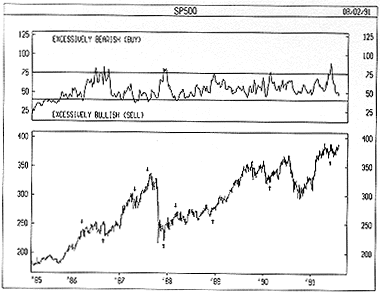
Technical Analysis from A to Z
by Steven B. Achelis
PUTS/CALLS RATIO
Overview
Developed by Martin Zweig, the Puts/Calls Ratio ("P/C Ratio") is a market sentiment indicator that shows the relationship between the number of Puts to Calls traded on the Chicago Board Options Exchange (CBOE).
Traditionally, options are traded by unsophisticated, impatient investors who are lured by the potential for huge profits with a small capital outlay. Interestingly, the actions of these investors provide excellent signals for market tops and bottoms.
Interpretation
A Call gives an investor the right to purchase 100 shares of stock at a pre-determined price. Investors who purchase Calls expect stock prices to rise in the coming months. Conversely, a Put gives an investor the right to sell 100 shares of stock at a pre-set price. Investors purchasing Puts expect stock prices to decline. (An exception to these general rules is that Puts and Calls can also be purchased to hedge other investments, even other options.)
Because investors who purchase Calls expect the market to rise and investors who purchase Puts expect the market to decline, the relationship between the number of Puts to Calls illustrates the bullish/bearish expectations of these traditionally ineffective investors.
The higher the level of the P/C Ratio, the more bearish these investors are on the market. Conversely, lower readings indicate high Call volume and thus bullish expectations.
The P/C Ratio is a contrarian indicator. When it reaches "excessive" levels, the market usually corrects by moving the opposite direction. The following table, general guidelines for interpreting the P/C Ratio. However, the market does not have to correct itself just because investors are excessive in their bullish/bearish beliefs! As with all technical analysis tools, you should use the P/C Ratio in conjunction with other market indicators.
| Table 12 | ||||
| P/C Ratio 10-day Moving Average | P/C Ratio 4-week Moving Average | |||
|---|---|---|---|---|
| Excessively Bearish (buy) | greater than 80 | greater than 70 | ||
| Excessively Bullish (sell) | less than 45 | less than 40 | ||
Example
The following chart shows the S&P 500 and a 4-week moving average of the Puts/Calls Ratio.

I drew "buy" arrows when investors were excessively pessimistic (greater than 70) and "sell" arrows when they were excessively optimistic (less than 40). The arrows certainly show that investors are buying Puts when they should be buying Calls, and vice versa.
Calculation
The Puts/Calls Ratio is calculated by dividing the volume of Puts by the volume of Calls.
![]()
Contents
- Preface
- Acknowledgments
- Terminology
- To Learn More
- Bibliography
- About the Author
- Technical Analysis
- Price Fields
- Charts
- Support & Resistance
- Trends
- Moving Averages
- Indicators
- Market Indicators
- Line Studies
- Periodicity
- The Time Element
- Conclusion
- Absolute Breadth Index
- Accumulation/Distribution
- Accumulation Swing Index
- Advance/Decline Line
- Advance/Decline Ratio
- Advancing-Declining Issues
- Advancing, Declining, Unchanged Volume
- Andrews' Pitchfork
- Arms Index
- Average True Range
- Bollinger Bands
- Breadth Thrust
- Bull/Bear Ratio
- Candlesticks - Japanese
- CANSLIM
- Chaikin Oscillator
- Commodity Channel Index
- Commodity Selection Index
- Correlation Analysis
- Cumulative Volume Index
- Cycles
- Demand Index
- Detrended Price Oscillator
- Directional Movement
- Dow Theory
- Ease of Movement
- Efficient Market Theory
- Elliott Wave Theory
- Envelopes (Trading Bands)
- Equivolume/Candlevolume
- Fibonacci Studies
- Four Percent Model
- Fourier Transform
- Fundamental Analysis
- Gann Angles
- Herrick Payoff Index
- Interest Rates
- Kagi
- Large Block Ratio
- Linear Regression Lines
- MACD
- Mass Index
- McClellan Oscillator
- McClellan Summation Index
- Median Price
- Member Short Ratio
- Momentum
- Money Flow Index
- Moving Averages
- Negative Volume Index
- New Highs-Lows Cumulative
- New Highs-New Lows
- New Highs/Lows Ratio
- Odd Lot Balance Index
- Odd Lot Purchases/Sales
- Odd Lot Short Ratio
- On Balance Volume
- Open Interest
- Open-10 TRIN
- Option Analysis
- Overbought/Oversold
- Parabolic SAR
- Patterns
- Percent Retracement
- Performance
- Point & Figure
- Positive Volume Index
- Price and Volume Trend
- Price Oscillator
- Price Rate-of-Change
- Public Short Ratio
- Puts/Calls Ratio
- Quadrant Lines
- Relative Strength, Comparative
- Relative Strength Index
- Renko
- Speed Resistance Lines
- Spreads
- Standard Deviation
- STIX
- Stochastic Oscillator
- Swing Index
- Three Line Break
- Time Series Forcast
- Tirone Levels
- Total Short Ratio
- Trade Volume Index
- Trendlines
- TRIX
- Typical Price
- Ultimate Oscillator
- Upside/Downside Ratio
- Upside/Downside Volume
- Vertical Horizonal Filter
- Volatility, Chaikin's
- Volume
- Volume Oscillator
- Volume Rate-of-Change
- Weighted Close
- Williams' Accumulation/Distribution
- Williams' %R
- Zig Zag